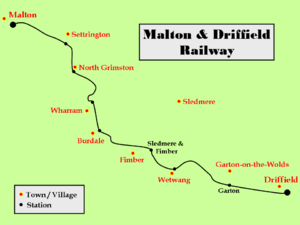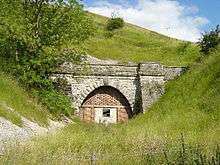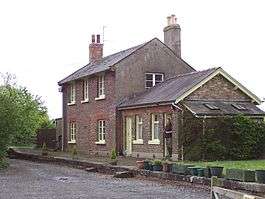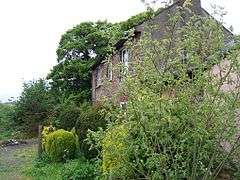Malton and Driffield Junction Railway
|
The approximate route of the Malton and Driffield Junction Railway. The stations were often a considerable distance from the villages they served. | |
| Dates of operation |
1853–Passenger: 3 June 1950 Freight: 20 October 1958 |
|---|---|
| Track gauge | 4 ft 8 1⁄2 in (1,435 mm) standard gauge |
| Length | 20 mi (32 km)[1] |
| Malton and |
|---|
Legend |
The Malton and Driffield Junction Railway, later known as the Malton and Driffield branch was a railway line in Yorkshire that ran between the towns of Malton, North Yorkshire and Driffield in the East Riding of Yorkshire.
The line opened on 13 April 1853. It became part of the North Eastern Railway (1854), then London and North Eastern Railway (1923), becoming part of British Railways in 1948. Passenger services on the line gained the nickname the Malton Dodger.
Between the 1920s and 1950s the line saw use transporting chalk from the Burdale and Wharram quarries. Passenger services ended in 1950; the Burdale quarry closed in 1955, and the line closed in 1958.
History
The Malton and Driffield Junction Railway (1846–1870)
Promotion of a line between Malton and Driffield dates to at least the mid 1840s when George Hudson subscribed £40,000 towards a Malton and Driffield Junction Company, which was intended to link to a proposed branch of the Great North of England Railway from Thirsk to Malton.[2][note 1] The Malton and Driffield Junction Railway was promoted as part of a line of communication from Hull to Newcastle-upon-Tyne and beyond to Scotland as well as opening up the agricultural districts of the East Riding of Yorkshire, and providing a short route to the new seaside resorts on the East Yorkshire coast. A connection via the proposed Thirsk and Malton Railway was required for the connections northward.[map 1] Both the Newcastle and Darlington Junction Railway (N&DJR) and York and North Midland Railways (Y&NMR) supported the scheme.[3]
A previous scheme from Thirsk to Driffield, the Hull, Malton and Northern Union Railway was resurrected and promoted in opposition,[note 2] but was unsuccessful.[4] An act empowering the construction of a 24 miles (39 km) line was enacted in June 1846, allowing £240,000 to be raised for its development through shares, and a further £80,0000 through loans.[5][note 3]
Part of the rationale for the line was a connection to the Thirsk and Malton Railway, which the Newcastle and Darlington Junction had obtained an act for (1846) but not built. A case was brought against that company's successor the York, Newcastle and Berwick Railway (YN&BR) to complete the line.[note 4] As a result, a second act was obtained with the work completed 1853.[6] The Malton and Driffield company subscribed £35,000 towards the scheme with the YN&BR contributing the other part.[note 5] In the same time period (1850s) the York and North Midland Railway held £40,000 worth of shares in the M&DJR.[5][note 6]
Construction
The engineer was John Cass Birkinshaw, the assistant engineer Alfred Lamert Dickens. In addition to the mainline from New Malton (on the York and Scarborough Railway[map 4]) to Great Driffield (on the Hull and Selby Bridlington branch[map 5]) the plans included a 5 miles 4.5 chains (8.14 km) branch from Frodingham Bridge. On the original plan the minimum curve was 20 chains (1,300 ft; 400 m) with maximum gradients of 1 in 60, and 1 in 158. The line also included a tunnel of 1,694 yards (1,549 m).[8]
The first seven miles (11 km) of the line from Malton included severe gradients, ascending, including 2.5 miles (4 km) at 1 in 70, and required heavy civil engineering works. The highest point of the line was within the tunnel. As built the line included a number of timber bridges, and a timber viaduct at Wharram. Land had been acquired for a double track line but only a single track was laid, using 65 pounds per yard (32.2 kg/m) weight rails, on cross sleepered track. The line was to be worked by the York, Newcastle and Berwick Railway, under the same rules as the Thirsk and Malton Line.[9]
Work on the line began in 1847,[10] and by 1849 over £100,000 had been expended on the construction of the line, the majority on works (£52,921) and permanent way (£31,597).[11] The bursting of the speculative bubble of the Railway Mania in the late 1840s adversely affected the line's prospects.[12] By early 1849 the company's calls on shares were in arrears.[11]
Financial problems caused the company to abandon the construction of a double track line and only construct a single line. In 1850 the company applied to parliament to alter the path of the line;[note 7] the amendment act was passed in 1851.[note 8][10]
By 1851 about half (10 miles or 16 kilometres) of the line had been completed as a single line; the 5-mile (8 km) branch was by then in abeyance.[5] In early 1852 the calls on shares were still in arrears requiring the company to funds by loans. An estimated £65,000 was required for the completion of the line; £40,000 had been borrowed by late January 1852; over £55,000 by mid 1852.[13]
Agreement was reached with the Y&NMR to pay a fee to use the station and track into Driffield.[14] The 19-mile (31 km) was opened formally 19 May 1853, becoming open to public traffic on 1 June.[15] The line had stations at Settrington,[map 6] North Grimston,[map 7] Wharram,[map 8] Burdale,[map 9] Fimber,[map 10][note 9] Wetwang,[map 11] and Garton;[map 12][10] Malton station and Driffield station were used as termini.[map 13][map 14]
Operations
On weekdays three passenger trains ran per day in each direction.[16]
Amalgamation
In the early 1850s The Leeds Northern (LNR), York, Newcastle and Berwick and York and North Midland railways were considering amalgamation, and in 1853 the M&DJR was admitted to that group of companies; and became part of joint traffic agreements.[17] In 1854 an act of parliament allowing the YN&BR, LNR and Y&NMR companies to amalgamate into a new "North Eastern Railway" (NER) was passed; the association of M&DJR was formally announced at the first meeting of the NER, where, the distribution of income was decided to be based on traffic receipts over the next 5 years; the M&DJR obtained one director of a board of seventeen, and the company ceased to exist as an independent entity from 1 September 1854.[18][note 10] In 1863 agreements relating to the merger of the Stockton and Darlington Railway (S&DR) set the Malton section's share of the combined company's profits at 0.29%, a sum which was not sufficient to meet running costs; the company attempted to renegotiate requesting a share of gross revenue, but were denied.[19]
Difficulties and disappointments arising from line were recalled in a scathing article in the Railway News, written on the eve of the consolidation or NER shares:[note 10][20]
The line was a gross mistake throughout – but was conceived in times when [..] high sounding notions of a "grand connecting link" in the "Hull and Glasgow Direct" were uppermost. [..] The hapless Malton and Driffield has never paid its interest on borrowed capital, is now £50,000 in debt, and is destined, we are told, to total annihilation.— Railway News (6 November 1869)[20]
History 1870–1958
In 1890 a line from Market Weigton was opened, promoted as the Scarborough, Bridlington and West Riding Junction Railway (act passed 1885), and worked by the NER.[21] The line made a junction with the M&DJR at Driffield (Driffield Junction West) just west of the M&DJR's junction with the Hull to Bridlington Line.[22][map 15]
As a result of the 1921 Railways Act, in 1923 the line became part of the London & North Eastern Railway (LNER). In 1948 after nationalisation of the railway as a result of the Transport Act 1947 the line became part of the North Eastern Region of British Railways.
In the 1920s the line was used to transport lime (chalk) from the quarry at Wharram (open 1918–1930) to the iron and steel industry on Teesside; the line handled around 100,000 tons per year.[16]
In 1922 a quarry opened and Burdale for the same purpose which provided work for the line until the quarry's closure in 1955.[16]
The route was closed to passenger traffic on 3 June 1950, with complete closure in 1958.[16]
Legacy
As of 2006 the track bed remains in evidence as field boundaries, earthworks, and undeveloped ground.[23] Short sections have been reused as footpaths (e.g. near Wharram Percy).[16] At Malton the former line of the railway influences modern street plans such as the rear boundary to Parliament Avenue. A fraction of the former line has been completely developed over such as at the housing development around Bracken Road in Driffield.[23]
As of 2005 the station buildings survive except at Sledmere and Fimber, and Burdale station.[16] Other extant structures include a crossing keepers cottage at Sledmere, and a brick water tower with iron water tank at Wharram.[24] Rail related buildings exist at the former quarry at Wharram.[16] The Burdale Tunnel portals were bricked up after closure and the interior experienced collapses in the 1970s and 1980s.[25]
Yorkshire Wolds Railway society
In October 2008 the Yorkshire Wolds Railway Restoration Project was formed with the aim to restore at least part of the Malton and Driffield railway line as a heritage attraction. If restored it would be the only heritage railway in the East Riding of Yorkshire.[26] In 2012 the group gained planning permission to build a visitors centre, near to the site of the former Fimber and Sledmere station.[27][28]
In September 2012, the project acquired its first vehicle, an ex Mark 1 coach Brake Gangwayed.[29] In 2013 the charity obtained its first locomotive, a GEC diesel shunter GECT5576.[30][31]
The Yorkshire Wolds Railway, first opened to the public on 24 May 2015, with the official opening by Sir Tatton Sykes on 25 May 2015. Currently it has a visitors centre and 110 yards (100 m) of demonstration track.[32]
|
Accidents
On 15 September 1948 a passenger train consisting of a tank engine and two coaches travelling 30 miles per hour (48 km/h) collided at an accommodation crossing with a Ford lorry carrying Poles and Hungarians going to work on a farm. As a result of the lorry running into the path of the train, three of the lorry passengers were killed and six others seriously injured, including the British driver. The train had minimal damage. The inquest recorded that the accident was caused by lack of caution by the driver, noted that the view at the crossing point was very poor, and that the driver may not have heard the train's whistle over the noise of the lorry engine.[33]
Locomotives and rolling stock
Based on written records and photographic evidence, the following locomotive types are known to have been used on the MDR in the indicated timeframes.
Goods locomotives
Pre-grouping (before 1923)
| Class (Designer) |
Former Class |
Wheel Arrangement |
Representative Image |
Examples Seen (Date) |
|---|---|---|---|---|
| NER Class 1001[34] (Bouch) | S&DR | 0-6-0 | Not confirmed but No. 1275 (shown on left) was allocated to Malton (until 1923) |
Pre-nationalisation (1923–1947)
| Class (Designer) |
Former Class |
Wheel Arrangement |
Representative Image |
Examples Seen (Date) |
|---|---|---|---|---|
| LNER Class A7 (Raven) | NER Class Y | 4-6-2T | (before 1939) | |
| LNER Class F4 (T.W. Worsdell) | GER Class M15 | 2-4-2T | 7578 (after 1945) | |
| LNER Class J3 (Gresley) | GNR Class J4 | 0-6-0 | 339 (during World War II) 4035 (during World War II) | |
| LNER Class J25 (W. Worsdell) | NER Class P1 | 0-6-0 | 5656 crashed at Settrington (1947) | |
| LNER Class J36 (Holmes) | NBR Class C | 0-6-0 | 9604 (during World War II) 9172 (during World War II) | |
| LNER Class J75 (M. Stirling) | H&BR Class G3 | 0-6-0T | (before 1939) | |
| LNER Class Q5 (W. Worsdell) | NER Class T & T1 | 0-8-0 | (before 1939) | |
| War Department (WD) Austerity Class 8F (Riddles) | - | 2-8-0 | (during World War II) |
Post-nationalisation (1948–18 October 1958)
| Class (Designer) |
Former Class |
Wheel Arrangement |
Representative Image |
Examples Seen (Date) |
|---|---|---|---|---|
| BR Class A8 (Gresley) | LNER Class A8 | 4-6-2T | 69861 at Wharram (1958) [Last train: Malton-Sledmere] | |
| BR Class J27 (W. Worsdell) | NER Class P3 | 0-6-0 | 65844 at Settrington (c. 1950) 65849 at Fimber (1956) | |
| BR Class J39 (Gresley) | LNER Class J39 | 0-6-0 | 64928 at Wetwang (1958)[35] 64938 at Settrington (1956)[36] | |
| BR Class 2MT (Ivatt) | LMS Class 2 | 2-6-0 | 46481 (1958) [Last through goods train] |
Passenger locomotives
Pre-grouping (before 1923)
| Class (Designer) |
Former Class |
Wheel Arrangement |
Representative Image |
Examples Seen (Date) |
|---|---|---|---|---|
| NER Fletcher 0-4-4T[34] of Unknown Type[note 11] (Fletcher) | 0-4-4T | |||
| NER Class A[34] (T. W. Worsdell) | later LNER Class F8 | 2-4-2T | ||
| NER Class O[34] (W. Worsdell) | later LNER Class G5 | 0-4-4T | ||
| NER Class W[34] (W. Worsdell) | later LNER Class A6 | 4-6-2T |
Pre-nationalisation (1923–1947)
| Class (Designer) |
Former Class |
Wheel Arrangement |
Representative Image |
Examples Seen (Date) |
|---|---|---|---|---|
| LNER Class J21 (T. W. Worsdell) | NER Class C | 0-6-0 | .png) | Double-headed train (Winter 1947) |
Post-nationalisation (1948–3 June 1950)
| Class (Designer) |
Former Class |
Wheel Arrangement |
Representative Image |
Examples Seen (Date) |
|---|---|---|---|---|
| BR Class G5 (W. Worsdell) | LNER Class G5 NER Class O | 0-4-4T | 67330 at Driffield (1949) 67293 at Driffield (1950) [Final passenger train] | |
| BR Class 4MT (Fowler) | LMS Class 4P | 2-6-4T | 42324 at Burdale Tunnel[37] |
Post-nationalisation (1948–1958)
| Class (Designer) |
Former Class |
Wheel Arrangement |
Representative Image |
Examples Seen (Date) |
|---|---|---|---|---|
| BR Class A2 (Peppercorn) | LNER Class A2 | 4-6-2 | 60534 'Irish Elegance' at Sledmere (1948)[38] [ Royal Train ] | |
| BR Class B1 (Thompson) | LNER Class B1 "Antelope" Class | 4-6-0 | 61010 'Wildebeeste' at North Grimston (1948) | |
| BR Class D20/1 (W.Worsdell) | NER Class R | 4-4-0 | 62387? at North Grimston (1957) [ BLS Tour ] | |
| BR Class D49 (Gresley) | LNER Class D49 "Shire" Class | 4-4-0 | 62731 'Selkirkshire' at Wharram (1957)[39] [ RCTS Special ] |
Notes
- ↑ The Hudson (York and North Midland) controlled Hull and Selby Railway (Bridlington branch) had opened in 1846, with a station at Driffield.
- ↑ "Hull, Malton and Northern Union Railway". The London Gazette (20534): 4377-4379. 15 November 1845.
- ↑ Malton and Driffield Junction Railway Act, 1846 (Cap. 77); "An Act for making a Railway from the Scarborough Branch of the York and North Midland Railway at Norton near Malton to the Bridlington Branch of the Hull and Selby Railway at Great Driffield, with a Branch therefrom."
- "Malton and Driffield Junction Railway", The London Gazette (20540): 5735-5376, 22 November 1845
- ↑ "Regina v. The York, Newcastle and Berwick Railway Company (2 June 1851)", English Reports in Law and Equity, 6, pp. 259–265, 1852
- ↑ Malton and Driffield Junction Railway Act, 1852 (Cap. 37); "An act enabling the Malton and Driffield Junction Railway Company to subscribe towards the Construction of the Thirsk and Malton Branch of the York, Newcastle, and Berwick Railway, and to make Arrangements as to their Capital; and for other Purposes."
- also : York, Newcastle, And Berwick Railway (Thirsk and Malton Branch) Act, 1852 (Cap. 36); "An act enabling the York, Newcastle, And Berwick Railway to make a Deviation in the Line of their Thirsk and Malton Branch; and to enable the Malton and Driffield Junction Railway Company to subscribe towards and enter in Agreements with respect to the said Branch; and for other Purposes."
- in : The Sessional Papers of the House of Lords, 40, 1852, pp. 164, 182, 185
- also : York, Newcastle, And Berwick Railway (Thirsk and Malton Branch) Act, 1852 (Cap. 36); "An act enabling the York, Newcastle, And Berwick Railway to make a Deviation in the Line of their Thirsk and Malton Branch; and to enable the Malton and Driffield Junction Railway Company to subscribe towards and enter in Agreements with respect to the said Branch; and for other Purposes."
- ↑ York and North Midland Railway Act, 1850 (Cap. 38); "An Act to alter the Terms of Issue of the Shares in the Capital of the York and North Midland Railway Company, called the "Hull and Selby Purchase, &c. Shares;" to enable the said Company to hold Shares in the Hull and Selby Railway Company and in the Malton and Driffield Junction Railway Company; to alter, amend, and extend the Acts relating to the York and North Midland Railway Company; and for other Purposes." [7]
- ↑ "Malton and Driffield Junction Railway". The London Gazette (21158): 3211. 26 November 1850.
- ↑ Malton and Driffield Junction Railway Amendment, 1851 (Cap. 39); "An Act to authorize certain Alterations in the Line and Levels of the Malton and Driffield Junction Railway, and to amend the Act relating thereto."
- ↑ Opened as Fimber Road in May 1853, renamed Sledmere in March 1858 and became Sledmere & Fimber in May 1859. The station closed in June 1950.
- 1 2 Tomlinson (1915, pp. 640–641) : Stock consolidation took place in 1870.
- ↑ Probably Fletcher 0-4-4T Bogie Tank Passenger (BTP) engines. According to (Jenkins, 2002), these were numerous and widely employed throughout the NER system.
References
- ↑ Railway Magazine November 1958 p. 801
- ↑ Tomlinson 1915, pp. 467, 480.
- ↑ "Malton and Driffield Junction Railway". Bradshaw's Railway Gazette. 2 (24): 408. 1 November 1845.
- ↑ Tomlinson 1915, p. 467.
- 1 2 3 Malton and Driffield Junction. Railway Intelligence. 30 September 1850. p. 21.
- ↑ LNER encyclopedia, para.6
- ↑ A Collection of the Public General Statutes passed in the Thirteenth and Fourteen Year of the Reign of Her Majesty Queen Victoria, 1850, p. xi
- ↑ Glynn, Henry (1847). Malton and Driffield Junction. Reference Book to the Incorporated Railway Companies of England and Wales, Alphabetically Arranged. John Weale. p. 105.
- ↑ (Appendix No.9) Malton and Driffield Junction Railway. Report to the Lords of the Committee of Privy Council for Trade and Foreign Plantations of the Proceedings of the Department relating to Railways. 1853. pp. 20–23.
- 1 2 3 Suggitt 2005, p. 105.
- 1 2 Scrivenor, Harry (1849). Malton and Driffield Junction. The Railways if the United Kingdom Statistically Considered ... Smith, Edler and Co. pp. 483, also 200–201, 204.
- ↑ LNER encyclopedia, para.4
- ↑ "Malton and Driffield Railway". Railway Record. 9. p. 55 (24 January); p. 64 (31 January); pp. 509, 513 (7 August). 1852.
- ↑ "The North Eastern Railway vs. North". The Law Times. 30: 325–326. 20 February 1858.
- ↑ Tomlinson 1915, p. 520.
- 1 2 3 4 5 6 7 Suggitt 2005, p. 107.
- ↑ Tomlinson 1915, pp. 518–520.
- ↑ Tomlinson 1915, pp. 525–526, 549, 778.
- ↑ Tomlinson 1915, pp. 609–610.
- 1 2 "The North Midland District". The Railway News. 7 (306): 474–5. 6 November 1869.
- ↑ Tomlinson 1915, p. 696.
- ↑ Ordnance Survey. 1890. Sheet 161SE
- 1 2 Ordnance Survey: 1:25000. 2006
- ↑ Suggitt 2005, images, pp.106, 107.
- ↑ "Burdale Tunnel". www.forgottenrelics.co.uk. Retrieved 4 July 2014.
- ↑ "Yorkshire Wolds Railway". Yorkshire Wolds Railway Restoration Project. Retrieved 11 December 2009.
- ↑ "Full steam ahead for railway plans". Hull Daily Mail. 25 May 2012. Retrieved 4 July 2014.
- ↑ "(12/00434/STPLF) Creation of a short heritage railway line and visitor facilities on part of the former Malton and Driffield Junction Railway, Fimber". East Riding of Yorkshire Council. 31 January 2012. Retrieved 4 July 2014.
- ↑ "Railway buys first attraction". Malton Mercury. 29 September 2012. Retrieved 4 July 2014.
- ↑ Yorkshire Wolds Railway's First Loco Arrives!. www.youtube.com (video). 24 April 2013. Retrieved 8 August 2014.
- ↑ "Yorkshire Wolds Railway gains its first locomotive". Railways Illustrated. Vol. 11. August 2013. p. 62.
- ↑ "Yorkshire Wolds heritage railway project opens". BBC News. BBC. 24 May 2015. Retrieved 6 June 2015.
- ↑ Woodhouse, E (1949), REPORT ON THE ACCIDENT which occurred on 15th September 1948, near GARTON in the NORTH EASTERN REGION, BRITISH RAILWAYS (PDF), Stationery Office
- 1 2 3 4 5 Burton 1998, p. 27.
- ↑ Burton 1998, p. 36.
- ↑ Burton 1998, p. 15.
- ↑ Undated postcard
- ↑ Burton 1998, p. 53.
- ↑ Burton 1998, p. 38.
Locations
- ↑ 54°08′03″N 0°46′45″W / 54.134263°N 0.779208°W, Scarborough junction (Malton)
- ↑ 54°03′23″N 0°40′20″W / 54.056395°N 0.672095°W, Burdale Tunnel (south)
- ↑ 54°04′05″N 0°41′10″W / 54.068006°N 0.686057°W, Burdale Tunnel (north)
- ↑ 54°08′02″N 0°47′04″W / 54.133862°N 0.784576°W, Junction with the York and Scarborough Railway
- ↑ 54°00′00″N 0°26′11″W / 54.000018°N 0.436353°W, Junction with the Hull and Selby (Bridlington branch)
- ↑ 54°06′55″N 0°43′20″W / 54.115336°N 0.722284°W, Settrington station
- ↑ 54°05′52″N 0°43′04″W / 54.097908°N 0.717774°W, North Grimston station
- ↑ 54°04′37″N 0°41′22″W / 54.076930°N 0.689380°W, Wharram station
- ↑ 54°03′02″N 0°40′11″W / 54.050638°N 0.669800°W, Burdale station
- ↑ 54°02′15″N 0°36′46″W / 54.037420°N 0.612745°W, Fimber station
- ↑ 54°01′28″N 0°34′36″W / 54.024413°N 0.576540°W, Wetwang station
- ↑ 54°00′30″N 0°30′19″W / 54.008269°N 0.505371°W, Garton station
- ↑ 54°07′55″N 0°47′50″W / 54.131919°N 0.797284°W, Malton station
- ↑ 54°00′05″N 0°26′04″W / 54.00142°N 0.43453°W, Driffield station
- ↑ 53°59′53″N 0°26′32″W / 53.998013°N 0.442286°W, Junction with the Driffield and Market Weighton line (1890)
Sources
- Burton, Warwick (1998). Malton & Driffield Junction Railway. Martin Bairstow. ISBN 1-871944-16-3.
- Suggitt, Gordon (2005), Lost Railways of North & East Yorkshire, ISBN 9781853069185
- Tomlinson, William Weaver (1915), The North Eastern Railway; its rise and development, Andrew Reid and Company, Newcastle; Longmans, Green and Company, London
- "The Malton & Driffield Junction Railway", The London & North Eastern Railway (LNER) Encyclopedia (www.lner.info)
External links
| Wikimedia Commons has media related to Malton and Driffield Railway. |
- "The Chalk Getters – A Wharram Study", British Pathé (video, silent), 1933, chalk quarry and M&DJR at Wharram
- The Yorkshire Wolds Railway Restoration Project






_-_geograph.org.uk_-_1937288.jpg)

.jpg)
